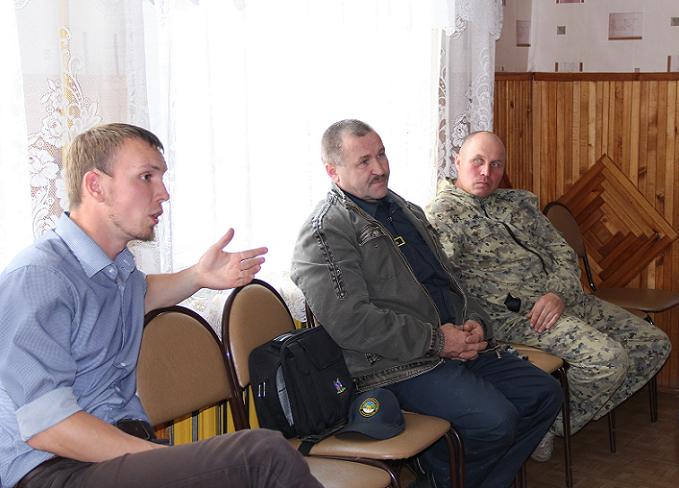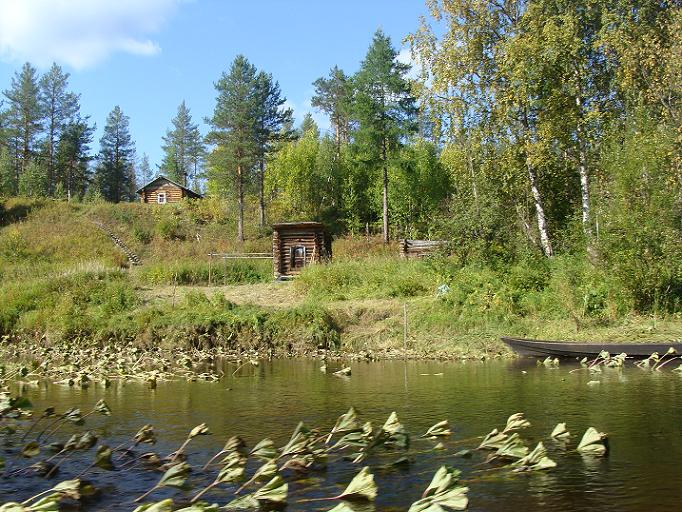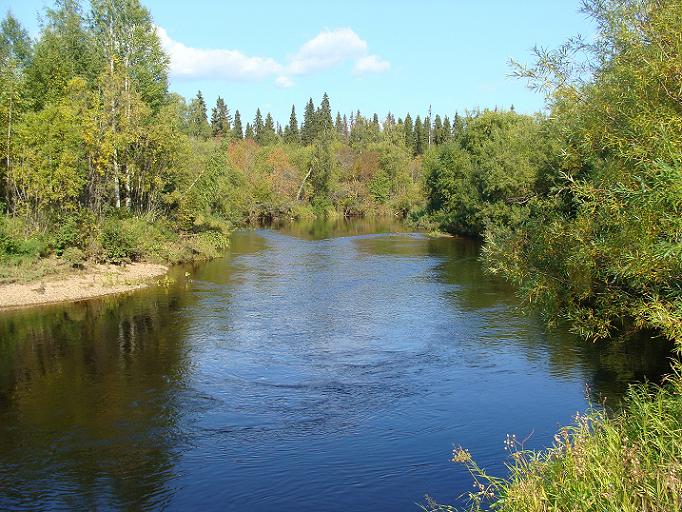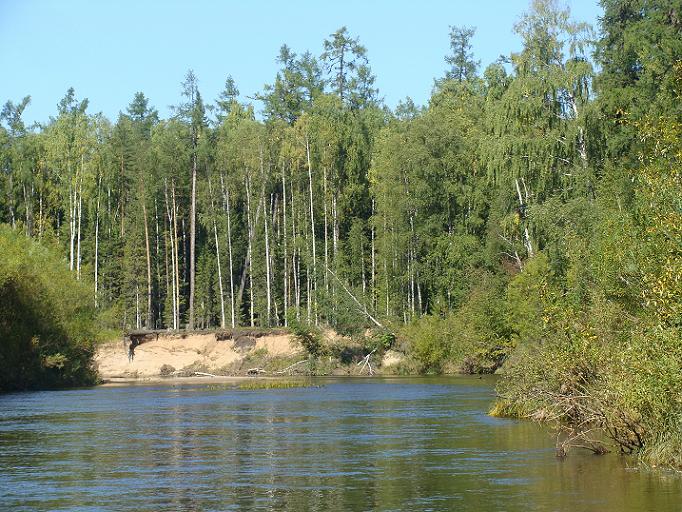Last week the Silver Taiga Foundation employees Nikolay Shilov and Nikolay Shuktomov met with the residents of Vazhgort and Chuprovo – the villages located on the Vashka river.
Up to now the main efforts within the frameworks of the Model River project were focused on the river Mezen itself. However, Vashka is its biggest tributary, and the largest part of the population of the Udora district lives in the villages of the so-called “Vashka bush”. Unfortunately, it can be said, that this area is neglected by the government services as well. For example, there is not a single fishery protection inspector along the whole length of the river. It happens rarely that somebody meets with the local population and information that they get comes not in full or even distorted. That is why it is not a mere coincidence that Natalya Ivanovna Vurdova, the senior inspector of the Department of state control, supervision and protection of aquatic bioresources in the Udora district, participated in this trip together with the “Silver taiga” ecologists.
In Vazhgort village mainly the local members of the “AgroUdora” cooperative came to the meeting. Having joined the cooperative back in the days, at the beginning they legally fished lampreys on the leased part of the river. Later they were not given quotas for lamprey and after some time fishing of any kind of migratory fish, including lampreys, was totally prohibited. People asked if, taking into consideration the new Regulations, the cooperative members would have any benefits compared with the amateur fishermen and if it is still possible to introduce the necessary changes in the Regulations, particularly, to permit fishing of lampreys.
– We tried to give answers to these and other questions of the meeting participants, – the ecologist Nikolay Shuktomov shares his impressions. – Besides, we told about the activities undertaken within the frames of the Model River Mezen project and participation of the local population in the project initiatives. Unfortunately, not many people came to the meeting, and those who came were mainly elderly people, there were almost no young participants.
In Chuprovo village our meeting passed more lively, there were more people of different ages, and it seemed to me, that they were more interested in the subject of the meeting, many questions were asked. May be it happened because this village, even compared with Vazhgort, lives much more separately. Different speeches were made, including claims, but finally a common language was found and, in general, the conversation was very effective. Moreover, thanks to the local people we could move 50 kilometers up the Ezhuga Zyryanskaya – a very beautiful and unique river. We listened to the stories of our guides about the history of these places with great pleasure. Here the tribal lands – hunting paths and huts of local hunters and fishermen – are preserved in many generations. There is fish here so far, probably, also because local people “watch” their river – they do not let “electrofisherers” and other poachers come here. The locals themselves, as they say, “know when enough is enough”. And it looks as if it’s true. The river is also good in terms of the fish reproduction: the food potential is preserved, and even though loggings are moving in this direction from the Arkhangelsk region, there is no significant impact: according to our guides, the leaseholder acts “moderately”, while the locals try to monitor the situation.
Unfortunately, in the villages standing on the Vashka very little is known about the aims of the Model River Mezen project. As it turned out, the local people do not know a lot about the biology of the river fish “population”: there is almost no information and knowledge from the specialists, and that connection, which helped in the past to hand down traditional knowledge from generation to generation, is terminated… That is why the minds of the people contain many “myths”, which very often even remotely do not reflect the reality.
Information support, certainly, can be rearranged. Today there is only one information channel working for the people from remote villages – a district newspaper and its thematic supplement, devoted to the problems of the river and fish. It is very likely that we will have to continue having such meetings, as well as educational seminars for the local residents and other forms of information exchange. “Silver Taiga” will obligatorily do it in full within the frames of the Mezen project. Today people have a very limited access to information, there are no platforms where they can discuss vital problems, and this definitely does not help neither to the development of the public self-government, nor to the efforts to establish the proper river resources management, nor to the introduction of the local initiatives – people do not believe they can change anything. And they need help.




The photos are made by Sergey Davydov
Library Readers Discuss the Mezen Problems
| News by silverA readers’ conference devoted to Fedor Abramov’s work “Once upon a time there lived a small salmon” was held on October 19 in the library of Usogorsk village. The conference was arranged within the frames of cooperation between the Silver Taiga Foundation and the Udora centralized library system (further – Udora CLS).
Read more
Schoolchildren Learn Their Origins
| News by silverThe beginning of a school year in the Udora district was marked with the first interschool research ecological conference “Origins”, conducted at the premises of the Vazhgort school. The conference, arranged in the frames of the Model River Mezen project, was focused on the support of the interest to flora and fauna of home places, building of the schoolchildren’s experience in ecological and area studies, development of public speaking skills, as well as exchange of the research experience among the pupils of different schools.
Read more
The First-year Students of the Syktyvkar Forest Institute Got Familiar with the History of Forest and Forest Use
| «Komi Model Forest» project by silverThis is the fourth consecutive year that the Silver Taiga Foundation together with the Syktyvkar Forest Institute (SFI) organize field excursions on the Komi Model Forest demonstration routes for the first-year students having entered the SFI.
Read more
Students of the International Forest School on the Routes of the Komi Model Forest
| «Komi Model Forest» project by silverA group of students from the Syktyvkar Forest Institute (further – SFI) and University of Applied Sciences and Arts of Goettingen (Germany) have visited the Komi Model Forest demonstration routes in the frames of the international Forest school.
Read more
Forest Soils of the Middle Taiga: Consequences of the Human Intervention
| «Komi Model Forest» project by silver7 soil scientists from different regions of Russia, participants of the 6th All-Russian Scientific Conference “Fundamental and applied aspects of forest soil science” that was held in Syktyvkar from September 14-19, visited demonstration objects of the Komi Model Forest during a scientific tour devoted to the current changes of the middle taiga forest soils. The tour was arranged and conducted by Yury Pautov (Silver Taiga Foundation) and Aleksey Dymov (Institute of Biology of the Komi Scientific Center of the Ural Branch of RAS).
Silver Taiga together with the Institute of Biology had preliminary prepared eight demonstration objects with soil profiles demonstrating different types of soils and their transformation after different kinds of human intervention.
What happens to forest soils after agricultural use? Do they recover after further overgrowing with forest and how fast does it happen? How do soils transform under the influence of loggings and what is the duration of these transformations, how do they influence on the processes of renewal and growth, and on the spatial structure of secondary forest stands forming in the logged areas? Does the fertility of forest soils affected by the modern heavy harvesters recover and how fast? These and many other questions engendered heated discussions between representatives of different scientific schools on each demonstration object.
The participants were especially impressed by the duration of the consequences of the impact on forest soils. During the tour they had a chance to see with their own eyes that even after 80 years since the former agricultural fields had been grown over, these consequences remain in the structural profile, in the mechanical and chemical content of soils.
As was mentioned by the tour participants, such objects are an optimal method of a scientific monitoring, and it’s a great merit of the Komi Model Forest project, as in the frames of this project the chronology and the sequence of the human intervention had been detected and all this had been shown on the maps and on site.
It must be noted that all data on the assessment of the impact of the forest use, as well as the results of the morphological and analytical studies of forest soils with different degree and different nature of the human intervention are represented in the guidebook of the scientific tour “Modern changes of the middle taiga forest soils”. This guidebook was prepared cooperatively by the Institute of Biology of the Komi Scientific Center of the Ural Division of RAS and the Silver Taiga Foundation and issued just before the conference. This publication shows the history of the forest use and related transformation of soils on the territory of the Syktyvdinsky and Priluzsky districts of the Komi Republic, describes demonstration objects of the tour route, gives brief reference information on the Komi Model forest.
Rainy weather did not affect the interest of the tour participants
At the review point of the route “Man and forest: history of relations”. Yury Pautov: “600 years ago these fields were a forest”
V.S. Stolbovoy, Dr.Sc. (Geography), from Moscow is evaluating the changes of the soil profile on the former skidding road after 30 years since logging
Photo by Alexey Dymov
I Want to Come to Work in Russia
| News by silverTatyana Dyukova, a student of the University of Eastern Finland and a future Master of Forestry Sciences, has undertaken a two months internship in the Komi Republic. The program of the internship was arranged in such a way that within eight weeks Tatyana had a chance to learn about the work of quite different participants of the forestry relations – from the forestry higher educational institution up to the industrial company. Tatyana passed some part of the internship in the Silver Taiga Foundation and we asked her to tell about her impressions and acquired skills.
Read more
People in the Remote Villages Do Not Believe They Can Change Anything
| News by silverLast week the Silver Taiga Foundation employees Nikolay Shilov and Nikolay Shuktomov met with the residents of Vazhgort and Chuprovo – the villages located on the Vashka river.
Up to now the main efforts within the frameworks of the Model River project were focused on the river Mezen itself. However, Vashka is its biggest tributary, and the largest part of the population of the Udora district lives in the villages of the so-called “Vashka bush”. Unfortunately, it can be said, that this area is neglected by the government services as well. For example, there is not a single fishery protection inspector along the whole length of the river. It happens rarely that somebody meets with the local population and information that they get comes not in full or even distorted. That is why it is not a mere coincidence that Natalya Ivanovna Vurdova, the senior inspector of the Department of state control, supervision and protection of aquatic bioresources in the Udora district, participated in this trip together with the “Silver taiga” ecologists.
In Vazhgort village mainly the local members of the “AgroUdora” cooperative came to the meeting. Having joined the cooperative back in the days, at the beginning they legally fished lampreys on the leased part of the river. Later they were not given quotas for lamprey and after some time fishing of any kind of migratory fish, including lampreys, was totally prohibited. People asked if, taking into consideration the new Regulations, the cooperative members would have any benefits compared with the amateur fishermen and if it is still possible to introduce the necessary changes in the Regulations, particularly, to permit fishing of lampreys.
– We tried to give answers to these and other questions of the meeting participants, – the ecologist Nikolay Shuktomov shares his impressions. – Besides, we told about the activities undertaken within the frames of the Model River Mezen project and participation of the local population in the project initiatives. Unfortunately, not many people came to the meeting, and those who came were mainly elderly people, there were almost no young participants.
In Chuprovo village our meeting passed more lively, there were more people of different ages, and it seemed to me, that they were more interested in the subject of the meeting, many questions were asked. May be it happened because this village, even compared with Vazhgort, lives much more separately. Different speeches were made, including claims, but finally a common language was found and, in general, the conversation was very effective. Moreover, thanks to the local people we could move 50 kilometers up the Ezhuga Zyryanskaya – a very beautiful and unique river. We listened to the stories of our guides about the history of these places with great pleasure. Here the tribal lands – hunting paths and huts of local hunters and fishermen – are preserved in many generations. There is fish here so far, probably, also because local people “watch” their river – they do not let “electrofisherers” and other poachers come here. The locals themselves, as they say, “know when enough is enough”. And it looks as if it’s true. The river is also good in terms of the fish reproduction: the food potential is preserved, and even though loggings are moving in this direction from the Arkhangelsk region, there is no significant impact: according to our guides, the leaseholder acts “moderately”, while the locals try to monitor the situation.
Unfortunately, in the villages standing on the Vashka very little is known about the aims of the Model River Mezen project. As it turned out, the local people do not know a lot about the biology of the river fish “population”: there is almost no information and knowledge from the specialists, and that connection, which helped in the past to hand down traditional knowledge from generation to generation, is terminated… That is why the minds of the people contain many “myths”, which very often even remotely do not reflect the reality.
Information support, certainly, can be rearranged. Today there is only one information channel working for the people from remote villages – a district newspaper and its thematic supplement, devoted to the problems of the river and fish. It is very likely that we will have to continue having such meetings, as well as educational seminars for the local residents and other forms of information exchange. “Silver Taiga” will obligatorily do it in full within the frames of the Mezen project. Today people have a very limited access to information, there are no platforms where they can discuss vital problems, and this definitely does not help neither to the development of the public self-government, nor to the efforts to establish the proper river resources management, nor to the introduction of the local initiatives – people do not believe they can change anything. And they need help.
The photos are made by Sergey Davydov
Justification of the Scopes of the Reclamation Works on the Irva Lakes is Ongoing
| «Model river «Mezen» project by silverThe Silver Taiga Foundation ecologists have finished the field works on the Irva Lakes, aimed at evaluation of the scope of the reclamation works necessary for cleaning of these lakes.
Read more
Field Works on the Mezen River Tributaries
| «Model river «Mezen» project by silverFollowing the investigations of the loggings’ impact on the river ecosystems, the Silver Taiga ecologists have conducted field works at the headwaters of the Mezen river – on its tributaries Kuzhim and Nizhnaya Puzla. Several dozens of samples of benthos and plankton taken from different areas of these water streams are forwarded for analyses to the Laboratory of Ichthyology and Hydrology of the Department of Animal Ecology, Institute of Biology of the Komi Scientific Center of Ural Branch of RAS – one of the Silver Taiga partners in the implementation of this project.
– This is another expedition in the series of expeditions that we organize for the environmental assessment of the loggings’ impact on water and biological resources of rivers, – the ecologist Nikolay Shilov says. – Why namely these two tributaries? They are interesting from the point of further comparison of the results: the Kuzhim is a very logged water stream, almost 50% of the forests in the basin of this river are logged; the Nizhnaya Puzla, on the contrary, suffered a little from the loggings (just 4% of the forests are logged here). It is important to find out how much the condition of water and biological resources of these rivers differ from each other because of this.
Except taking samples, we had another task – an assessment review of the situation on the Kuzhim river. During a six-hour rafting along this river, we had the opportunity to make visual estimation of the degree of disturbances and conditions of fish reproduction. It has to be sad that these are mainly the river areas with adjacent roads and bridges that get sanded, but in general, we got the impression that the reproduction conditions are good. At the same time, unfortunately, along the entire length of the rafting we have not seen any grayling. It is most likely that the fish population is severely depleted due to overfishing. Besides, this is a side effect of the economic activities.
Students Dmitry Gromov (Syktyvkar State University), Tatyana Dyukova (University of Eastern Finland), and a volunteer Sergey Belousov have taken part in the field works on the tributaries of the Mezen together with the Silver Taiga staff.
National Risk Assessment for FSC Controlled Wood of the Komi Republic Approved
| News by silverOn July 20, 2015 the Department of Policy and Standards of the International FSC Center approved the national risk assessment for FSC controlled wood of the Komi Republic.
As reported in the press release of the Russian National FSC Office, “the National Risk Assessment (NRA) prepared for the entire territory of the Russian Federation in 2013, continues to have effect. However, it has been additionally amended for the Komi Republic. The amendments have been included in Addendum 8 “Additional risk assessment requirements for the Forest Stewardship Council controlled wood of the Komi Republic” and shall be subject to compulsory implementation since July 20, 2015.”
It is to be recalled that the development of the Komi Regional risk assessment for FSC controlled wood was completed in January of this year. It had been done by a specially formed Working Group in the framework of the joint project of the Silver Taiga Foundation and the Russian National FSC Office. Based on the national risk assessment and considering the specifics of the Komi Republic, the group had developed the regional document, which will allow the certified companies to effectively assess the risks when purchasing wood from uncertified suppliers.
This is important for the forest industry of Komi, because the certified enterprises working on the territory of the republic are buying part of wood from uncertified suppliers, and this wood should be monitored to exclude illegal one, or the one harvested in violation of the traditional and civil rights of the local population, or cut in the high conservation value forests. The Working group, including representatives of different stakeholders – forest business, non-governmental organizations, and local population, has addressed in detail all the indicators and identified the degree of risk (low or undetermined). The evaluation has been conducted at the level of forestry units of the Komi Republic. The Technical Committee of the National FSC Working Group considered the final document, taking into account the comments and proposals, and provided it for accreditation to the FSC International.
The Silver Taiga Foundation thanks the Working Group members for their contribution to the development of the document.
The national risk assessment with the regulatory addendum on the Komi Republic is available on the website of the Russian National FSC office and on the International FSC website.